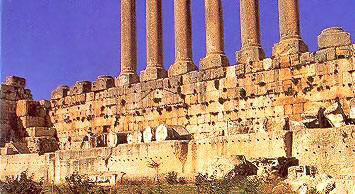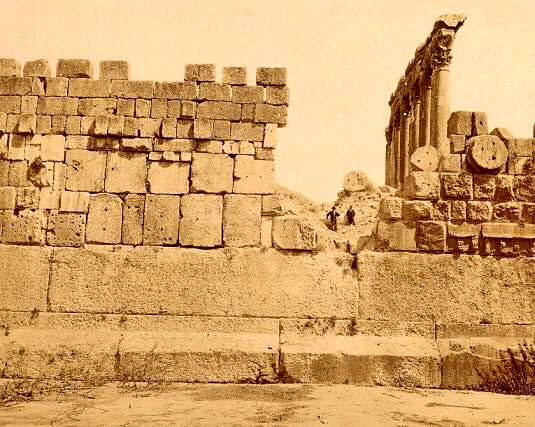The Roman temple Heliopolis, which parts are still standing in the figure seen below, was built on a much older site. The original site was thousands of years older. Indications are that the Romans used this site for their temple, was because of the massive foundation that was previously built. Note from the picture below, the Roman temple falls short on one side of the original foundation , while it is true and flush with the other side of the foundation. This indicates that the foundation was not built for the Roman temple, but was built much earlier. It's original purpose is unknown.

Take note of the two men in the centre of the picture below, and their size comparison to the foundation stones, directly below them. These cut and heavily worked stones are the largest formed stones in the history of the world. Some are weighing upwards to 1500 short tons. Each of these stones is unique in that it is cut and formed for one precise location.

The first thing of notice is that the stones above the early foundation stone seemed to be laid quite haphazard. The reasons are somewhat unclear, but it seems these stones were gathered much later, after the Roman temple had fallen into disrepair, and reformed into a fortress. This could have been the work of the Crusaders, though that is unclear.
What this does clearly indicate, is that early mankind, was highly skilled. and able to build technically advanced buildings, with seemingly no tools. Designing the buildings often begins with failures. After a number of attempts, construction techniques evolve. My problem is not the building itself but the tools used, considering that copper and bronze were the only such tools available.
An example of this is the drilling for oil in the 20th century. Early oil wells were quite shallow and often found in sedimentary regions. The early technique for finding oil was dropping a drill bit down a well hole over and over again, or by punching the bit deeper into the ground. This type of operation took upwards to a year to put a hole into an oil formation. This was somewhat effective until the bit hit a rock formation.
Hughes Drilling, (Howard Hughes) from California, then discovered the rotary bit, which enabled drilling into rock formations and finding America's oil pools . This allowed for the huge discovery of oil, and the eventual wealth and advancement of America. My point is a proper tool was required to advance mankind.
No tool that we know of today, would allow these ancient people to build, construct, and move these huge megalithic stones into a foundation site. Bottom picture is the largest crane in the world, and it's still barely big enough.
Two Questions;
How were these giant stone cut and formed?
How were these giant stone moved, and elevated into position? I'm not sure any modern machine today could perform this feat.
There is No proof or indication of what this early temple foundation was built for, and any attempt at explaining this is only pure speculation. Local legends do tell of the structure predating the flood. After it was partially destroyed by the flood waters it was later said to be rebuilt by "giants". Are these the "giants" mentioned in the Bible and in the Book of Enoch as the Nefilim? The sons of the great gods. Was this an ancient temple or monument built by the Nefilim, for their own purpose?
This can be said however; considering the size and the amount of resources required in it's construction, the site was extremely important to someone, or some group of people.
The Yangshan quarry in China also has these megalith stones that defy logic.
Again what was their purpose and why so large? Whether in Egypt (Minyu quarry) or in Peru or in China or in Russia's far east these large stones of vast weight leave our known history of early mankind in total question.
Mankind has a simple rule in his life endeavors. It relates to a ratio of man's size and strength to his endeavors.. A man milks a cow, rides a horse, pets his dog, has his tools for building, builds his home. All these activities relate to his size and strength. Small things that are manageable can become large things, as in large skyscrapers. But in no time in man's history can/has man build 40 to 60 to 1200 ton megalithic stone blocks that were intended for a structure's construction.
All things relating to man's abilities are related to his size and strength. This not science it's common sense. So the question is; why and who would build something so huge it becomes totally unmanageable.
One thing is plain, No human hands built these ancient megalithic structures. That's a true statement.



Ask Raphael how he laid these stones in place? A means to contain Azazel to imprisoned him. If this is Dudael then it fits the Enoch narrative.70 Generations until his judgement.
ReplyDeleteThank-you for your comment
ReplyDelete